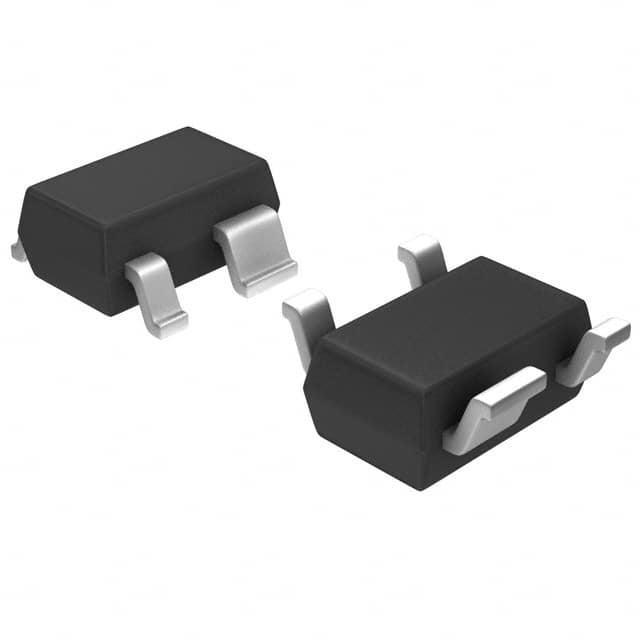S-80914CNNB-G8JT2U
Product Overview
Category
S-80914CNNB-G8JT2U belongs to the category of integrated circuits (ICs).
Use
This IC is commonly used in electronic devices for voltage detection and reset functions.
Characteristics
- Low power consumption
- High accuracy
- Wide operating voltage range
- Small package size
- RoHS compliant
Package
The S-80914CNNB-G8JT2U IC is available in a compact surface mount package.
Essence
The essence of this product lies in its ability to accurately detect voltage levels and provide a reset signal when necessary, ensuring proper functioning of electronic devices.
Packaging/Quantity
The S-80914CNNB-G8JT2U IC is typically packaged in reels or tubes, with a quantity of 3000 units per reel/tube.
Specifications
- Supply Voltage Range: 1.6V to 5.5V
- Detection Voltage Accuracy: ±1.0%
- Operating Temperature Range: -40°C to +85°C
- Output Configuration: Open-drain
- Reset Delay Time: 100ms (typical)
- Quiescent Current: 1μA (typical)
Detailed Pin Configuration
The S-80914CNNB-G8JT2U IC has the following pin configuration:
- VDD (Supply Voltage)
- GND (Ground)
- RESET (Reset Output)
Functional Features
- Accurate voltage detection: The IC can detect voltage levels within the specified range with high precision.
- Reset function: When the voltage falls below the detection threshold, the IC generates a reset signal to ensure proper device operation.
- Low power consumption: The IC operates with minimal power consumption, making it suitable for battery-powered applications.
- Wide operating voltage range: The IC can operate within a wide range of supply voltages, providing flexibility in various applications.
Advantages and Disadvantages
Advantages
- High accuracy voltage detection
- Low power consumption
- Compact package size
- Wide operating voltage range
Disadvantages
- Reset delay time may not be suitable for certain time-critical applications.
- Limited availability of alternative models with similar specifications.
Working Principles
The S-80914CNNB-G8JT2U IC works based on the principle of comparing the input voltage with a reference voltage. When the input voltage falls below the detection threshold, the internal circuit generates a reset signal, which can be used to initiate a system reset or perform other necessary actions.
Detailed Application Field Plans
The S-80914CNNB-G8JT2U IC finds applications in various electronic devices where accurate voltage detection and reset functions are required. Some potential application fields include:
- Battery-powered devices: The IC ensures proper operation by monitoring the battery voltage and initiating a reset when necessary.
- Microcontrollers and embedded systems: It provides a reliable reset signal to ensure correct initialization and operation of these systems.
- Industrial automation: The IC can be used in control systems to monitor power supply voltages and trigger appropriate actions in case of voltage fluctuations.
Detailed and Complete Alternative Models
While the S-80914CNNB-G8JT2U IC offers specific features and characteristics, there are alternative models available from different manufacturers that provide similar functionality. Some alternative models worth considering are:
- S-80915CNNB-G8JT2U
- S-80916CNNB-G8JT2U
- S-80917CNNB-G8JT2U
These alternative models offer comparable voltage detection accuracy, operating voltage range, and package options, providing flexibility in choosing the most suitable IC for specific applications.
In conclusion, the S-80914CNNB-G8JT2U IC is a highly accurate and low-power voltage detection and reset IC. Its compact size, wide operating voltage range, and reliable functionality make it suitable for various electronic devices across different industries.
Word count: 511
Senaraikan 10 soalan dan jawapan biasa yang berkaitan dengan aplikasi S-80914CNNB-G8JT2U dalam penyelesaian teknikal
Sure! Here are 10 common questions and answers related to the application of S-80914CNNB-G8JT2U in technical solutions:
Q: What is S-80914CNNB-G8JT2U? A: S-80914CNNB-G8JT2U is a specific model of voltage detector IC (integrated circuit) manufactured by a company called Seiko Instruments. It is commonly used in various technical solutions.
Q: What is the purpose of S-80914CNNB-G8JT2U? A: The purpose of S-80914CNNB-G8JT2U is to detect and monitor voltage levels in electronic circuits or systems. It provides a reliable way to determine if the voltage exceeds or falls below a certain threshold.
Q: How does S-80914CNNB-G8JT2U work? A: S-80914CNNB-G8JT2U works by comparing the input voltage with a fixed reference voltage. If the input voltage crosses the threshold, it triggers an output signal indicating the change in voltage level.
Q: What is the operating voltage range of S-80914CNNB-G8JT2U? A: The operating voltage range of S-80914CNNB-G8JT2U is typically between 1.6V and 6.0V.
Q: Can S-80914CNNB-G8JT2U be used in battery-powered applications? A: Yes, S-80914CNNB-G8JT2U can be used in battery-powered applications as it operates within the typical voltage range of many batteries.
Q: Is S-80914CNNB-G8JT2U suitable for automotive applications? A: Yes, S-80914CNNB-G8JT2U is suitable for automotive applications as it can handle the voltage requirements of most automotive systems.
Q: What is the output configuration of S-80914CNNB-G8JT2U? A: S-80914CNNB-G8JT2U has an open-drain output configuration, which means it can be connected to other devices or circuits to drive external components.
Q: Can S-80914CNNB-G8JT2U be used in industrial control systems? A: Yes, S-80914CNNB-G8JT2U can be used in industrial control systems as it provides accurate voltage monitoring and detection capabilities.
Q: Does S-80914CNNB-G8JT2U have any built-in protection features? A: Yes, S-80914CNNB-G8JT2U has built-in overvoltage and undervoltage detection, which helps protect the circuitry from potential damage.
Q: Are there any application notes or reference designs available for S-80914CNNB-G8JT2U? A: Yes, Seiko Instruments provides application notes and reference designs that can help users understand and implement S-80914CNNB-G8JT2U in their technical solutions.
Please note that the answers provided here are general and may vary depending on specific use cases or requirements. It is always recommended to refer to the manufacturer's datasheet and documentation for detailed information.


